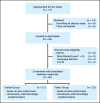Use of video to facilitate end-of-life discussions with patients with cancer: a randomized controlled trial
- PMID: 19949010
- PMCID: PMC3040012
- DOI: 10.1200/JCO.2009.24.7502
Use of video to facilitate end-of-life discussions with patients with cancer: a randomized controlled trial
Erratum in
- J Clin Oncol. 2010 Mar 10;28(8):1438
Abstract
Purpose: To determine whether the use of a goals-of-care video to supplement a verbal description can improve end-of-life decision making for patients with cancer.
Methods: Fifty participants with malignant glioma were randomly assigned to either a verbal narrative of goals-of-care options at the end of life (control), or a video after the same verbal narrative (intervention) in this randomized controlled trial. The video depicts three levels of medical care: life-prolonging care (cardiopulmonary resuscitation [CPR], ventilation), basic care (hospitalization, no CPR), and comfort care (symptom relief). The primary study outcome was participants' preferences for end-of-life care. The secondary outcome was participants' uncertainty regarding decision making (score range, 3 to 15; higher score indicating less uncertainty). Participants' comfort level with the video was also measured.
Results: Fifty participants were randomly assigned to either the verbal narrative (n = 27) or video (n = 23). After the verbal description, 25.9% of participants preferred life-prolonging care, 51.9% basic care, and 22.2% comfort care. In the video arm, no participants preferred life-prolonging care, 4.4% preferred basic care, 91.3% preferred comfort care, and 4.4% were uncertain (P < .0001). The mean uncertainty score was higher in the video group than in the verbal group (13.7 v 11.5, respectively; P < .002). In the intervention arm, 82.6% of participants reported being very comfortable watching the video.
Conclusion: Compared with participants who only heard a verbal description, participants who viewed a goals-of-care video were more likely to prefer comfort care and avoid CPR, and were more certain of their end-of-life decision making. Participants reported feeling comfortable watching the video.
Conflict of interest statement
Authors' disclosures of potential conflicts of interest and author contributions are found at the end of this article.
Figures




References
-
- Jemal A, Murray T, Ward E, et al. Cancer statistics, 2005. CA Cancer J Clin. 2005;55:10–30. - PubMed
-
- Boyle P, Ferlay J. Cancer incidence and mortality in Europe, 2004. Ann Oncol. 2005;16:481–488. - PubMed
-
- Emanuel LL, Danis M, Pearlman RA, et al. Advance care planning as a process: Structuring the discussions in practice. J Am Geriatr Soc. 1995;43:440–446. - PubMed
-
- Gillick MR. A broader role for advance medical planning. Ann Intern Med. 1995;123:621–624. - PubMed
Publication types
MeSH terms
Grants and funding
LinkOut - more resources
Full Text Sources
Medical

